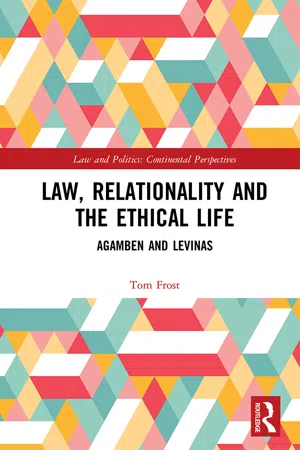
Law, Relationality and the Ethical Life
Agamben and Levinas
Tom Frost
- 256 Seiten
- English
- ePUB (handyfreundlich)
- Über iOS und Android verfügbar
Law, Relationality and the Ethical Life
Agamben and Levinas
Tom Frost
Über dieses Buch
This first book-length study into the influence of Emmanuel Levinas on the thought and philosophy of Giorgio Agamben, Law, Relationality and the Ethical Life, demonstrates how Agamben's immanent thought can be read as presenting a compelling, albeit flawed, alternative to Levinas's ethics of the Other.
The publication of the English translation of The Use of Bodies in 2016 ended Giorgio Agamben's 20-year multi-volume Homo Sacer study. Over this time, Agamben's thought has greatly influenced scholarship in law, the wider humanities and social sciences. This book places Agamben's figure of form-of-life in relation to Levinasian understandings of alterity, relationality and the law. Considering how Agamben and Levinas craft their respective forms of embodied existence – that is, a fully-formed human that can live an ethical life – the book considers Agamben's attempt to move beyond Levinasian ethics through the liminal figures of the foetus and the patient in a persistent vegetative state. These figures, which Agamben uses as examples of bare life, call into question the limits of Agamben's non-relational use and form of existence. As such, it is argued, they reveal the limitations of Agamben's own ethics, whilst suggesting that his 'abandoned' project can and must be taken further.
This book will be of interest to scholars, researchers, graduate students and anyone with an interest in the thought of Giorgio Agamben and Emmanuel Levinas in the fields of law, philosophy, the humanities and the social sciences.